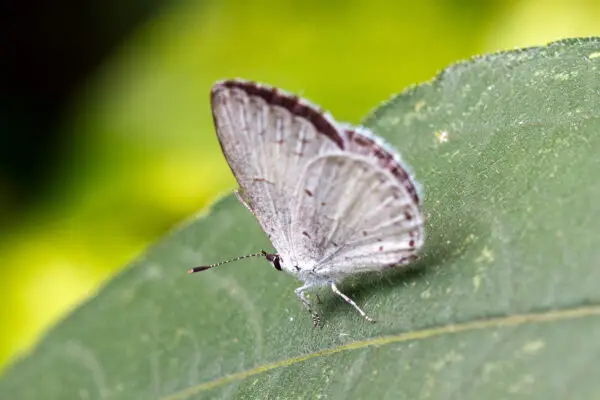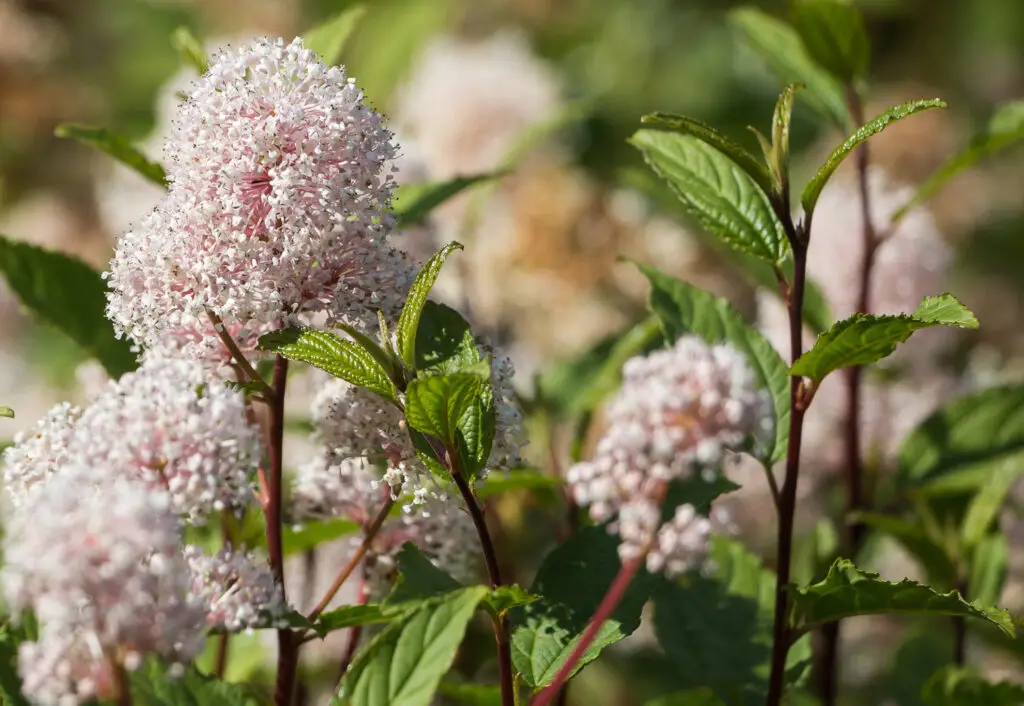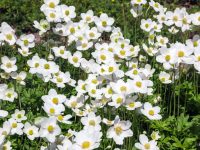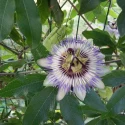This is a beautiful, sweet little shrub. In early summer, New Jersey Tea covers itself with fragrant, white flower clusters. The flowers may remind you of non-native lilacs or other native shrubs like Buttonbush or Sweetshrub. New Jersey Tea grows to around three feet high, making it perfect surrounded by native perennial flowers and trees. Scroll on for planting tips.

New Jersey Tea is one of those stunning native shrubs that once you see in bloom, you need to have in your garden. In this article, we’ll discuss some benefits to growing it, ideas on where to find it, and end with some companion planting ideas.
Let’s start with a quick, obvious question you may have:
Can you drink tea from New Jersey Tea?
New Jersey Tea’s green leaves have indeed been used for tea. According to the USDA, “Tribes of the Missouri River region used the leaves for tea and the roots for fuel on hunting trips. Tribes of the Great Lakes Bioregion ascribed great power to its treatment of bowel troubles…It was used by colonists during the Revolutionary War as a substitute for tea even though the leaves contained no caffeine.”
Recently, New Jersey Tea’s roots have been found to have blood-clotting abilities. It shows how powerful native plants are and will continue to be.
What does New Jersey Tea tea taste like?
Its tea tastes a little like pepperminty black tea.
Why is it called ‘New Jersey’ tea?
Why New Jersey and not Pennsylvania or Florida, where it’s also native? The Blog Eat the Weeds explains that prior to the Revolutionary War, this plant was known as ‘Red Root Tea.’ Its common name became ‘New Jersey Tea’ because it was so common in the New Jersey Pine Barrons region.
Today, we have individual Latin names to help us quickly (and accurately) identify plants. To ensure you’ve got a New Jersey Tea, look for its Latin name: Ceanothus americanus.
Now, let’s share some incredible benefits of planting New Jersey Tea.

What are the benefits of planting New Jersey Tea?
There are so many benefits to planting this native shrub. Some benefits include:
- Easy-care: once native New Jersey Tea is established (which usually takes the first year), it thrives with just rain
- Flowers every early summer: New Jersey Tea’s flowers appear on new growth from June through to July
- Short, statement-friendly landscaping: Lots of shrubs can get too tall for foundation or garden planting, and require annoying pruning. New Jersey Tea’s small three-foot height makes them fuss-free landscaping choices.
- Wildlife magnet: Hummingbirds, butterflies, and pollinators love New Jersey Tea’s blooms.
- Nitrogen-fixing superpowers: it might be surprising, but very few plants can pull nitrogen from the air and soil and convert it into a usable form. New Jersey Tea is one of these amazing nitrogen-fixing plants. (Other nitrogen fixers include False Blue Indigo and native lupines.)
And finally, one more benefit to mention:
New Jersey Tea is the host plant for 30+ butterflies and moths
A host plant is a specific plant on which a butterfly or moth lays its eggs and which its caterpillars eat. While our childhood stories may have us imagine caterpillars chowing down on all sorts of leaves, the truth is that many of the caterpillars of our most iconic butterflies—monarchs and swallowtails among many others—only eat specific plants.
These remarkable plants for picky caterpillars are called host plants.
New Jersey Tea is a host plant for 37 butterfly and moth species, including:
New Jersey Tea helps all these butterflies!



As you consider planting this beautiful native shrub, we have a few tips:
Sadly, New Jersey Tea is a favorite of deer
Deer love to nibble this plant. And it’s not only deer that nibble it; other wildlife, like rabbits, can nibble it, too. This may be partly why New Jersey Tea regenerates its shoots in the spring (after dying back in the winter). Perhaps the plant has evolved to know it might be snacked on and knows to grow back every year.
Perhaps we should call it Deer Phoenix Shrub?
If you’re sad about the deer, we have some good news:
New Jersey Tea is drought-tolerant
This shrub has a root structure that’s similar to carrots in that New Jersey Tea has a taproot. Plants with taproots store water and nutrients in their thick roots they can pull from during periods of drought. (Think of a taproot like a plant’s water bottle.) Other plants with taproots include False Blue Indigo and Butterfly Weed.
This taproot makes it difficult to move once its established
When planting New Jersey Tea, take a moment to plan where you place it. That taproot does not like being disturbed. Moving a New Jersey Tea once it’s growing happily can either weaken or kill the plant.

Where is New Jersey Tea native?
New Jersey Tea is native to many more states than you may think! It’s native to a wide portion of North America, from Nova Scotia to Florida, west to Texas. If you live in the Northeast, Mid-Atlantic, Midwest, or Southern United States, you can happily plant New Jersey Tea.
Because New Jersey Tea has such a vast range, it is helpful to find plants from sellers or sources closest to you. As you can imagine, a New Jersey Tea with generations of DNA from New Hampshire might not have the heat resiliency of a New Jersey Tea from Arkansas.
We made a silly rhyme to help remember:
Plants and seeds grown close to home are tuned to your soil, weather, and pollinators. Stay within 500 miles—or about a day’s drive—to help your garden thrive naturally.
Where can I find New Jersey Tea?
Finding a specific native plant can be a little challenging if you look in the big-box garden centers. We’re here to give some ideas on better places to look.
Here are four reliable ways to source native plants like New Jersey Tea:
Where can I find seeds and plants?
Finding native plants can be challenging (we partly blame Marie Antoinette.) To make it easier, we’ve assembled four sourcing ideas.
300+ native nurseries make finding one a breeze
Explore 100+ native-friendly eCommerce sites
Every state and province has a native plant society; find yours
Online Communities
Local Facebook groups are a great plant source
Northeastern Native Plant Digest has a nice overview video that shows the plant’s shape alongside planting tips:
What are good pairings for New Jersey Tea?
A great rule of thumb when planting a garden is to pick native plants that bloom from spring to fall, so that pollinators always have a treat. Since New Jersey Tea blooms in the summer, pick some other great natives that bloom in the spring and fall to plant alongside. Some ideas include:
Native plants for the spring
Native plants for the fall
If picking native plants feels overwhelming, try three-color landscaping. Pick three colors (one of which will be white, since you’re planting New Jersey Tea) and stick to that palette. Here’s our guide to Three-Color Native Gardens to make it easy.
That sums up our love letter to planting native gem New Jersey Tea. These beautiful and striking native shrubs have been strangely overlooked in landscaping—let’s change that! Since they are perennials, plant once, and they will come back year after year. Don’t forget to pair them with natives that bloom in the spring and fall, so your garden will always be filled with flowers and pollinators. Happy planting!
Sources
- New England Wild Flower Society. “Ceanothus Americanus.” New England Wild Flower Society, n.d. https://plantfinder.nativeplanttrust.org/plant/Ceanothus-americanus.
- Lady Bird Johnson Wildflower Center, Ceanothus americanus.
- USDA Plants Database, Ceanothus americanus.
- NC State Extension, Plant Toolbox, Ceanothus americanus.
- Wynia, R.L. 2010. Plant fact sheet for New Jersey tea (Ceanothus americanus). USDA-Natural Resources Conservation Service, Manhattan Plant Materials Center. Manhattan, KS 66502. (PDF.)
What if your feed was actually good for your mental health?
Give your algorithm a breath of fresh air and follow us.































